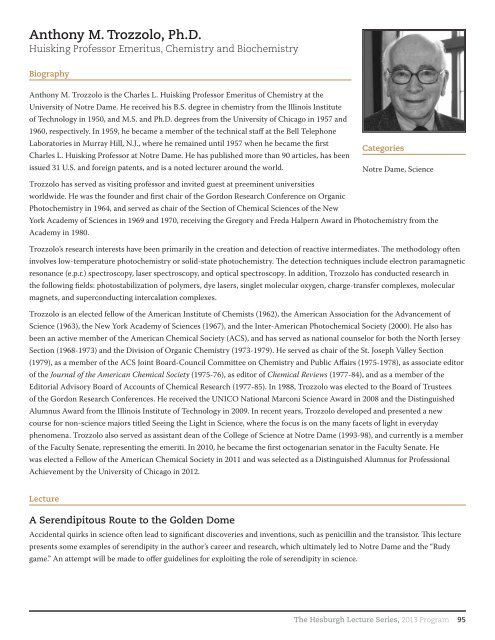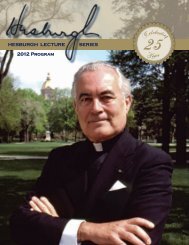HESBURGH LECTURE SERIES 2013 Program - Alumni Association ...
HESBURGH LECTURE SERIES 2013 Program - Alumni Association ...
HESBURGH LECTURE SERIES 2013 Program - Alumni Association ...
Create successful ePaper yourself
Turn your PDF publications into a flip-book with our unique Google optimized e-Paper software.
Anthony M. Trozzolo, Ph.D.<br />
Huisking Professor Emeritus, Chemistry and Biochemistry<br />
Biography<br />
Anthony M. Trozzolo is the Charles L. Huisking Professor Emeritus of Chemistry at the<br />
University of Notre Dame. He received his B.S. degree in chemistry from the Illinois Institute<br />
of Technology in 1950, and M.S. and Ph.D. degrees from the University of Chicago in 1957 and<br />
1960, respectively. In 1959, he became a member of the technical staff at the Bell Telephone<br />
Laboratories in Murray Hill, N.J., where he remained until 1957 when he became the first<br />
Categories<br />
Charles L. Huisking Professor at Notre Dame. He has published more than 90 articles, has been<br />
issued 31 U.S. and foreign patents, and is a noted lecturer around the world.<br />
Notre Dame, Science<br />
Trozzolo has served as visiting professor and invited guest at preeminent universities<br />
worldwide. He was the founder and first chair of the Gordon Research Conference on Organic<br />
Photochemistry in 1964, and served as chair of the Section of Chemical Sciences of the New<br />
York Academy of Sciences in 1969 and 1970, receiving the Gregory and Freda Halpern Award in Photochemistry from the<br />
Academy in 1980.<br />
Trozzolo’s research interests have been primarily in the creation and detection of reactive intermediates. The methodology often<br />
involves low-temperature photochemistry or solid-state photochemistry. The detection techniques include electron paramagnetic<br />
resonance (e.p.r.) spectroscopy, laser spectroscopy, and optical spectroscopy. In addition, Trozzolo has conducted research in<br />
the following fields: photostabilization of polymers, dye lasers, singlet molecular oxygen, charge-transfer complexes, molecular<br />
magnets, and superconducting intercalation complexes.<br />
Trozzolo is an elected fellow of the American Institute of Chemists (1962), the American <strong>Association</strong> for the Advancement of<br />
Science (1963), the New York Academy of Sciences (1967), and the Inter-American Photochemical Society (2000). He also has<br />
been an active member of the American Chemical Society (ACS), and has served as national counselor for both the North Jersey<br />
Section (1968-1973) and the Division of Organic Chemistry (1973-1979). He served as chair of the St. Joseph Valley Section<br />
(1979), as a member of the ACS Joint Board-Council Committee on Chemistry and Public Affairs (1975-1978), as associate editor<br />
of the Journal of the American Chemical Society (1975-76), as editor of Chemical Reviews (1977-84), and as a member of the<br />
Editorial Advisory Board of Accounts of Chemical Research (1977-85). In 1988, Trozzolo was elected to the Board of Trustees<br />
of the Gordon Research Conferences. He received the UNICO National Marconi Science Award in 2008 and the Distinguished<br />
Alumnus Award from the Illinois Institute of Technology in 2009. In recent years, Trozzolo developed and presented a new<br />
course for non-science majors titled Seeing the Light in Science, where the focus is on the many facets of light in everyday<br />
phenomena. Trozzolo also served as assistant dean of the College of Science at Notre Dame (1993-98), and currently is a member<br />
of the Faculty Senate, representing the emeriti. In 2010, he became the first octogenarian senator in the Faculty Senate. He<br />
was elected a Fellow of the American Chemical Society in 2011 and was selected as a Distinguished Alumnus for Professional<br />
Achievement by the University of Chicago in 2012.<br />
Lecture<br />
A Serendipitous Route to the Golden Dome<br />
Accidental quirks in science often lead to significant discoveries and inventions, such as penicillin and the transistor. This lecture<br />
presents some examples of serendipity in the author’s career and research, which ultimately led to Notre Dame and the “Rudy<br />
game.” An attempt will be made to offer guidelines for exploiting the role of serendipity in science.<br />
The Hesburgh Lecture Series, <strong>2013</strong> <strong>Program</strong> 95



